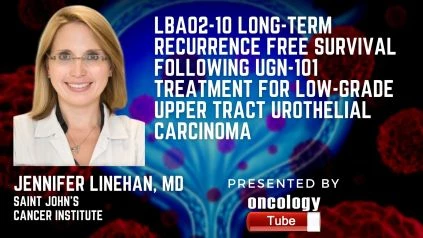Jennifer Linehan, M.D., Associate Professor of Urology and Urologic Oncology at Saint John’s Cancer Institute, Investigator of the OLYMPUS trial speaks about LBA02-10 Long-term Recurrence Free Survival Following UGN-101 Treatment For Low-grade Upper Tract Urothelial Carcinoma.
Link to Abstract:
https://www.auajournals.org/doi/abs/10.1097/JU.0000000000002149.10
A summary –
OBJECTIVE AND INTRODUCTION:
In individuals with tiny, unifocal tumors, radical nephroureterectomy (RNU) or nephron-sparing endoscopic surgery is the standard therapy for low-grade upper tract urothelial carcinoma (LG UTUC) affecting the renal pelvis and calyces. Patients who had a complete response (CR) after induction therapy with UGN-101 (JELMYTO), a mitomycin-containing reverse thermal gel, had an estimated response durability of 84 percent at 12 months in the OLYMPUS study (NCT02793128). We present here additional long-term durability data from patients in the OLYMPUS study who were followed up after its approval.
METHODS:
In the OLYMPUS study, 71 individuals were recruited and given one dose of UGN-101. At the first illness evaluation, which took place 4-6 weeks after the end of induction treatment, 42 (59%) of these patients had attained CR. At the 12-month follow-up, 23 patients had maintained CR, with the median duration of response unknown. Following the study’s completion, updates on disease status for the 23 patients with durable CR were gathered biannually (data cutoff 04 Mar 2021) and are provided below.
RESULTS:
Data on the duration of response (DOR) was available for 15 of the 23 individuals who had a long-lasting CR. Five of the remaining eight patients were enrolled at sites that had not yet begun the follow-up procedure, two had no new data since the last OLYMPUS evaluation, and one was lost to follow-up. Among the 15 individuals that were available, the median (range) DOR was 28.1 months (14.6 to 37.1 months). The DOR was computed as the period from the first reported CR to the latest satisfactory illness assessment or disease recurrence or death (for patients with ongoing CR). 12 (80.0%) patients had a continuing CR, 2 (13.3%) patients experienced a recurrence of LG UTUC in the ipsilateral side as treated, and 1 (6.7%) patient had undergone RNU as of the data cutoff date. Both individuals who had a recurrence of their illness received endoscopic ablation. RNU was done because of a left ureteral stricture, and no indication of UTUC was present at the time of surgery. There was no progression to high-grade UTUC or metastasis in any of the patients. At the time of the latest follow-up, disease-specific survival was 100 percent.
CONCLUSIONS:
Long-term follow-up shows that therapy with UGN-101 for LG UTUC can provide a long-lasting response that may outlast surgical nephron-sparing methods like laser ablation (42 percent recurrence after a median follow-up of 32 months). The study’s limitations include a limited sample size and no follow-up patient data.

